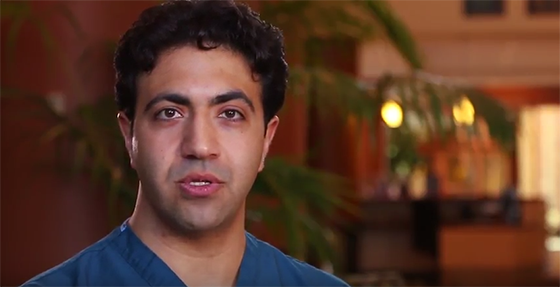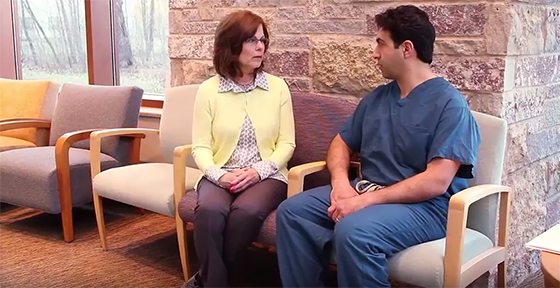About The Condition
 The gallbladder is a pear-shaped, fluid-filled organ located under your liver that stores and concentrates bile made by the liver. Bile helps in the digestion of foods and fats, and is released from the gallbladder into the small intestine (duodenum) when you eat. Conditions that slow or stop the flow of bile out of the gallbladder result in gallbladder disease. Symptoms can include pain, usually in the upper right side of the abdomen, nausea, vomiting, fullness or bloating, fever or chills, jaundice (yellowing of the skin or eyes) or heartburn. Gallbladder disease can include:
The gallbladder is a pear-shaped, fluid-filled organ located under your liver that stores and concentrates bile made by the liver. Bile helps in the digestion of foods and fats, and is released from the gallbladder into the small intestine (duodenum) when you eat. Conditions that slow or stop the flow of bile out of the gallbladder result in gallbladder disease. Symptoms can include pain, usually in the upper right side of the abdomen, nausea, vomiting, fullness or bloating, fever or chills, jaundice (yellowing of the skin or eyes) or heartburn. Gallbladder disease can include:
- Biliary Dyskinesia. When bile cannot move efficiently through the gallbladder, you may have biliary dyskinesia. Surgeons can remove the gallbladder, which enables the bile to flow directly from your liver to your small intestines. Most people can live a normal life without a gallbladder.
- Gallbladder Cancer. If you develop gallbladder cancer, surgeons will remove the gallbladder, which enables the bile to flow directly from your liver to your small intestines. Most people can live a normal life without a gallbladder.
- Gallstones. Gallstones are a common digestive tract disorder that form when bile hardens. In most cases, surgeons remove the gallbladder, eliminating your pain and enabling the bile to flow directly from your liver to your small intestines. Most people can live a normal life without a gallbladder.
Before Surgery
If your condition involves cancer, you may have radiation or chemotherapy prior to your surgery to reduce the size of your tumor. Your physician will provide you with more information. In addition, or for other surgeries, you may be asked to:
- Stop smoking for one month prior to your surgery. Nicotine decreases blood flow, prevents healing after surgery and increases your risk of infection.
- Increase your activity. Aim for 30 minutes of walking or other aerobic activity daily to build strength.
- Improve your nutrition. Add protein supplements such as Boost or Ensure to help your body heal after surgery.
Please ask your physician about any additional steps you should take before your surgery.
Surgery
Our surgeons perform open surgery, as well as minimally invasive surgeries, for gallbladder diseases. This procedure is called a cholecystectomy – or removal of the gallbladder. Sometimes, part of the liver needs to be removed, as well. Your surgeon will explain your particular procedure in more detail.
Minimally invasive surgery. Minimally invasive surgery is performed with laparoscopy or robot-assisted surgery using the da Vinci Surgical System.
- Laparoscopic surgery. Laparoscopic surgery requires only a few small incisions into which your surgeon will fit long, thin surgical instruments and a tiny camera. The camera will provide images to guide the surgeon during the procedure.
- Robotic surgery. Some laparoscopic surgeries may be performed using the da Vinci Surgical System. This robotic option gives your surgeon a magnified 3D high-definition view inside your body. The system also enables the surgeon’s hand movements to be translated into precise movements of small instruments inside your body.
- Watch Dr. Jenabzadeh talk about Robotic Single Site gallbladder surgery
- Watch a patient testimonial on Robotic Single Site gallbladder surgery
Open surgery. Minimally With open surgery, your physician will make an incision at the site of the abnormality large enough so he or she can see and touch your internal organs while operating.
After Surgery
- You will be encouraged to walk to prevent blood clots, muscle weakness and constipation.
- You may not be hungry at first, so return to a normal diet slowly. Start with a bland, low-fat diet for the first one or two weeks. Check with your physician about using supplements if your appetite is poor.
- You may experience constipation. If so, you may take a laxative such as Miralax or Milk of Magnesia.
- Ice may help to reduce the swelling for the first 48 to 96 hours. Then use heat to ease muscle soreness and relax tight muscles.
- You may use ibuprofen in addition to prescription pain medication to help with pain control.
- A small amount of bleeding or drainage is expected from the wound during the first one or two days.
- You may shower one or two days after surgery, but avoid baths, hot tubs, soaking or swimming for at least two weeks.
- Always talk to your surgeon about weight restrictions and return-to-work options.
- Most patients who have had laparoscopic or robotic surgery are discharged the same day of their surgery.
- You will be asked to see your surgeon in one to three weeks after surgery.
- If you notice a fever greater than 101 degrees Fahrenheit or drainage from your wound, let your surgeon know by calling 763.780.6699.
If you have additional questions, please contact us at 763.780.6699.












